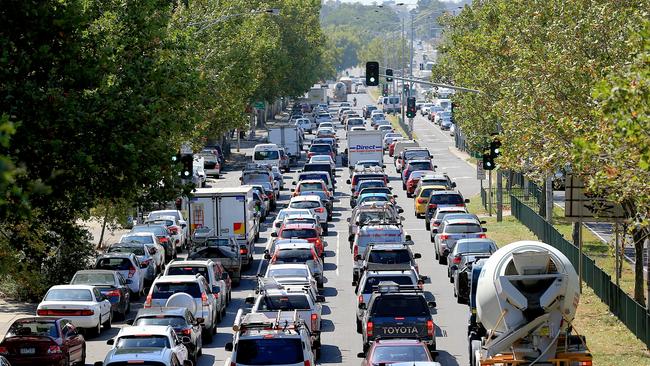Road congestion could worsen in a post-pandemic Melbourne
Melbourne’s traffic woes could worsen after restrictions ease, with commuters tipped to shun public transport and opt for the security of their own cars.

Victoria
Don't miss out on the headlines from Victoria. Followed categories will be added to My News.
Melbourne could emerge from the pandemic with worse congestion, with surging truck numbers tipped to fuel future traffic snarls as people shun public transport.
New data from obtained by the Herald Sun shows thousands of previously unseen trucks and cars flooded Melbourne streets as restrictions were eased.
The figures, collected by Here Technologies, tracked movements between April and June reveal an alarming uptick in traffic despite many people working from home and have sparked warnings Melbourne is heading for a congestion crunch.
The number of trucks thundering down Punt Rd rose by nearly a quarter over this time while the Tullamarine recorded 289,798 extra truck journeys over the space of a month.
The research also showed 30 per cent of people are receiving online orders once per week, up from 17 per cent before restrictions were introduced.
Here Technologies director of business development, Daniel Antonello said these were new challenges likely to create bigger gridlock problem as people return to work.
“We believed its going to be very congested and its obvious it’ll happen pretty quickly,” he said.
“As people were going to work and deliveries remained up we saw a glimpse of that.
“There was much more traffic in Melbourne in July than in April but much of the population was still working from home.”
Mr Antontello said authorities would have to address a bottleneck of extra motorists because of concerns over public transport.
“We need heavy vehicles to cover those deliveries from the depot to the door,” he said.
“We will need to connect the supply chain together more efficiently and transparently. Technology is crucial in that.”
Victorian Transport Association chief executive Peter Anderson said his group would petition for truck curfews to be reconsidered as restrictions are eased to help prevent bottlenecks.
“The transport industry has been busier than ever because of online shopping spikes and consumers becoming more confident about sourcing household goods from the internet,” he said.
“We expect this trend to continue when restrictions start to be lifted because people have experienced the ease and convenience of shopping online.”
Public Transport Minister Ben Carroll said the pandemic had completed changed the way we move around Melbourne.
“But once restrictions ease, we know people will want to return to doing the things they love rather than sitting in traffic or waiting for a train,” he said.
Six new incident response crews and additional traffic engineers have been hired to help improve the road network, along with 700 new CCTV cameras 200 wireless sensors.
LOOMING GRIDLOCK
How traffic changed between restrictions
TULLAMARINE FREEWAY
Total number of trucks in April – 1,927,496
Total number of trucks in June – 2,217,294
+ 289,798 trucks (15 per cent)
Average travel time for cars on 22nd and 23rd April – 2.98 minutes
Average travel time for cars on 22nd and 23rd July – 3.07 minutes
3.3 per cent slower
MONASH FREEWAY
Total number of trucks in April – 12,375,207
Total number of trucks in June – 13,345,771
+ 970,564 trucks (7 per cent)
Average travel time for cars on, April 18 – 2.81 minutes
Average travel time for cars on July 18 – 2.86 minutes
1.6 per cent slower
PUNT ROAD
Total number of trucks in April – 425,391
Total number of trucks in June – 528,726
+ 103,335 trucks (24 per cent)
Average travel time for cars on April 18 – 2.47 minutes
Average travel time for cars July 18 – 2.88 minutes
18 per cent slower
WEST GATE FREEWAY*
Total number of trucks in April – 6,208,635
Total number of trucks in June – 6,912,301
+ 703,666 trucks (11 per cent)
* Car travel time data not available for this road.
BY the numbers
30 per cent of people using line delivery each week, up from 17 per cent
During COVID-19 the most used services for delivery were:
– Takeaway food – 46 per cent
– Clothing – 38 per cent
– Groceries 39 per cent
MORE NEWS
WHY ROAD TOLL IS SURGING DESPITE A LOT LESS TRAFFIC
‘HEARTLESS’ COUNCIL TO DITCH CHAPEL ST CAR PARKING
